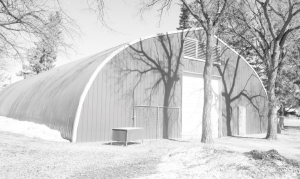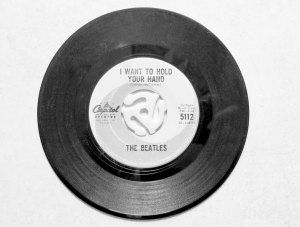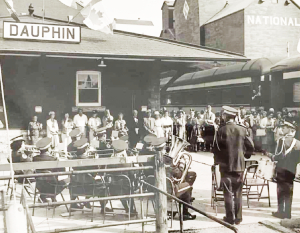Submitted
Dogs are a man’s, and a boy’s best friend
By Ed Stozek
For the Herald
Upon arrival at a farmyard the first contact usually involves a greeting by the official “guardian” of the premises, the family dog.
The term “a dog is man's best friend” was first coined in 1789 by King Frederick of Prussia claiming, “the only, absolute and best friend that a man has in his selfish world, the only one that will not betray or deny him, is his dog.”
For many years our farm dog was my best friend. We had many great outdoor adventures during my formative years.
After listening to the exploits of Sergeant Preston and his dog King on the radio, as well as reading novels regarding sled dog Buck in The Call of the Wild, it made me think of the possibilities of training my dog to pull a sleigh or a wagon.
After several futile attempts he flatly refused to co-operate. Other young lads raised in a rural setting had more success in training their farm dogs.
Clifford Hadway’s parents, Morris and Helen, lived one-half mile south from the Rigby one-room country school.
Walking or riding a bicycle was the preferred way to get to school during the non-winter months. When snow blanketed the countryside, seven-year old Clifford, a Grade 2 student, had an alternative mode of transportation.
Rintie, the Hadway’s farm dog, always gave Clifford a ride to and from school. As noted in the February 24, 1955, edition of the Dauphin Herald, “This has been going on for two years. Clifford trained four-year old Rintie well. Rintie is a faithful dog. He has never refused to do his duty.”
In the morning Rintie was harnessed and then hitched up to a small wooden sled. Clifford hopped on and off they went to school. When they arrived at the school Clifford told Rintie to go home. As 4 p.m. approached, the Hadways hitched Rintie up to the sled and sent him off with the command, “Go for Clifford.”
When Rintie arrived at the school Clifford was always waiting for him. He boarded the sled in preparation for an exciting journey home from school.
In a recent conversation Clifford noted that Rintie was just an ordinary farm dog, totally white in colour. Under Rintie’s “dog power” the rides to school on the wooden sled with red runners and a steering wheel continued for several more years.
My friend Elmer told a story of the use of “dog power” at Winnipegosis. He remarked that his cousin used a dog to haul water as the well water at his farm was not suitable for drinking. Many rural and town people got their water from a well next to the Sass store in Winnipegosis. When drinking water was needed, Elmer’s cousin harnessed the dog and hitched him up to a toboggan. Two empty cream cans were loaded onto the toboggan and the journey began. Once they arrived at their destination the cream cans were filled with well water and it was time to head back to the farm. On one occasion the dog was in a hurry to get home and took off at full speed. By the time Elmer’s cousin caught up to the toboggan, the dog had navigated the load into a ditch and all of the water spilled. They had to go back to town and start the process again.
Another friend shared another dog story. Using a homemade harness that his mother made, Delmar first harnessed and then hitched up the farm dog, Toby, to a small sleigh.
Walking side by side, they ventured several times a month on a two-mile trek to get groceries at Smaluck’s Store at Petlura. Delmar also mentioned that Toby was easy to train and loved pulling the sleigh so much that he would eagerly step into his harness in anticipation of any upcoming trip.
A young boy and his dog always have a special connection. Even though my dog didn't co-operate in pulling a sleigh or wagon, his affection, loyalty and dedication made for many good years of sharing our company with each other.
Countless adventures were experienced on weekends and on days when I arrived home after school.
Walkathon fund-raiser leads to new outdoor pool
By Ed Stozek
For the Herald
There have been times when we purchase a raffle ticket or pledge someone for Jump Rope for Heart, Relay for Life or other fund-raising events.
A walkathon is a popular fund-raising event involving participants collecting pledges and sponsorships from donors in exchange for walking a set distance. Participants then collect money for every mile that they walk or get a flat donation to raise funds for a charity or an organization.
Walkathons are often community events that involve fun, action and appeal to a large audience.
Several weeks prior to a 25-mile “Walk to Swim” fund-raising event sponsored by the Lions and Kinsmen clubs for Dauphin’s new outdoor swimming pool, Lions club president, Bob Robinson, issued a challenge to all of the other service clubs. Dressed in a knight’s outfit and a multi-layered pair of work socks, Robinson challenged the presidents of other organizations including Rotary, B.P.O. Elks, Oddfellows, Knights of Columbus, Masons, Shriners, Dauphin Commercial Travellers, Kinsmen, Toastmasters and the Dauphin Volunteer Fire Department to participate.
“Because of my youth, my energy, and my unparalleled physical condition, I feel confident that I will not only finish the walk, but I will win the race.” (June 14, 1968, Dauphin Herald).
There was a friendly rivalry between the various clubs and their members. For example, Bill Zaporzan, president of the Dauphin Toastmasters club, announced that he would accept the challenge and believed that Robinson would lose ground by at least a quarter mile for every mile that the two walked. Zaporzan also counter challenged for the loser to pay $5 per mile towards the pool project.
As an added incentive for the June 23 fund-raiser, all participants were promised a crest as well as a ballot for a draw. Free season passes would be awarded to 25 lucky winners. The slogan, “Help youth, help yourself and help Dauphin, sponsor someone in the walk”, encouraged my wife Janice and her good friend Carol to canvas for some pledges, slip on their running shoes and along with many other participants, enjoyed a 25-mile walk on a warm sunny Manitoba day.
The walkathon commenced at 8 o’clock on Sunday morning from the front of the court house. The participants walked down River Avenue and turned left at the highway leading to Winnipegosis. The group then turned right at the Stoney Point Road and walked east for eight miles, turning south and walking in the proximity of Lake Dauphin before heading west and arriving on Main Street. The end of the route occurred at the CKDM radio station.
Almost 400 people took part in the “Walk to Swim’ walkathon. A group of pastors and others who could not walk on Sunday did their bit on Saturday. Toby Dick, a Dauphin student from Cormorant, completed the course in four hours and 25 minutes. He was closely followed by Calvin Chute. The first female to cross the finish line was Sandra McKillop.
With pledges amounting to $11 per mile, Dauphin’s mayor, Hugh Dunlop, agreed to walk 10 miles. A final walkathon total was unavailable, however, with widespread interest both locally and nationally, at least $6,000 was pledged. Monies were to be turned in to the Royal Bank.
The Lions Club publicly thanked all of the citizens, “who generously contributed financially, walking, publicity, supplies, food, etc. It is felt that each and every one gave their fullest in making the project a total involvement.” (July 5, 1968, Dauphin Herald).
Built by Panoramic Pools from Winnipeg, the 30x75-ft. aqua container was the largest of its kind in Manitoba and opened to the public on August 17. With scheduled public swim times at 10 a.m. to noon, 1 p.m. to 5 p.m. in the afternoon and 6 p.m. to 9 p.m. in the evening, 25 cents garnered admission for children 12 and under, 50 cents for students and 75 cents for adults.
Recreational director Coots Riehl noted that standard pool regulations included, “No running around the pool, no food or drink in the pool area and everyone must shower before being allowed into the heated pool. For added safety, two lifeguards were to be on duty at all times.” (August 16, 1968, Dauphin Herald).
Nice buns
Dawn Recknell recently tried her hand at making beet leaf buns for the first time, but in addition to making a bunch of regular sized buns, the 79-year-old decided to make two supersized buns, which measured seven inches in length, each one enough for one meal.
Recknell made the two extra large buns just for fun.
Long playing records take the place of once popular 45s
By Ed Stozek
For the Herald
Thumbing through a collection of vinyl LPs (long playing records) evokes many memories.
During my teen years an old Philips record player in my parent’s living room made it possible to listen to a modest collection of music on LPs and 45 rpm records.
In 1948, Columbia Records unveiled the 33-1/3 rpm LP. Rpm denoted revolutions per minute, an indication of how fast the record was meant to spin on the turntable.
Sized at 12 inches in diameter, 15 to 22 minutes of recorded music was formatted per side. In response to Columbia, RCA Victor came up with the seven-inch 45 rpm record with approximately five minutes of music per side. Major record labels used the 33-1/3 format for LPs and the 45s for single record songs. Record players had a switch to change speeds for each record format.
My parents occasionally drove to Shoal Lake to shop for groceries. My favourite stop included the local radio and television shop to peruse the store’s collection of 45 rpm records. Nickels, dimes and quarters were used to purchase popular titles such as “I Want To Hold Your Hand” by The Beatles.
Since LPs and 45s had different sized centres most people of my generation recall the yellow “spider” adapter used to make the 45s compatible to the spindle utilized for LPs. Since the 45 record only had one song per side it was time to switch to only buying LP records. LPs featured 10 to 12 songs from a favourite solo artist or group and generally cost $3.99.
My classmates and I often discussed the latest popular hit songs and rock bands during our high school years. We brought our favourite 45s or LPs and used the school record player to listen to songs by The Monkees, The Beatles, The Rolling Stones and other popular groups.
During my university years, my appreciation of popular recording artists continued. Over 50 years later, several songs from that era still stand the test of time. Recorded in June and July 1970, the double live album, “4 Way Street” by Crosby, Stills, Nash and Young featured great harmonies and interesting guitar arrangements in stereo. It became an instant classic offering songs such as “Teach Your Children” and “Ohio.” It was the best of both worlds featuring an acoustic set, as well as a full rock band set.
James Taylor released Sweet Baby James in 1970. “Fire and Rain” soon became my favourite song. It was a challenge to learn its intricate guitar riffs. In 1971, “Horse With No Name” was released by the group America. It was an easy song to learn as it only had two chords. It was also the first song that I performed in public at a function at Brandon University. 1972 heralded Neil Young’s solo album, “Harvest”, with a number one hit song, “Heart of Gold” and another favourite, “Old Man.”
Gordon Lightfoot also proved to be a popular choice of a recording artist. For one of my university courses, the “Canadian Railroad Trilogy” and “Black Day in July” were used for a presentation showing how songs related to historical events.
One of the first household items that my wife Janice and I invested in shortly after we were married included a turntable, amplifier and a pair of sweet-sounding speakers. Other popular formats for playing music included 8-track tapes. Our car had an 8-track player and it always “clicked” to another track during the best part of a song.
The cassette format also became popular. Tapes periodically got tangled up and it was always an adventure to take the case apart to untangle the mess or try to splice a broken part with Scotch tape. Until the advent of digital compact discs in the mid-1980s, we continued to listen to our collection of
LPs played on our stereo system.
LP records are currently making a comeback as the vinyl format provides a warmer, more authentic sound compared to digital recordings.
Nostalgia also plays a part for those who lived through the golden age of vinyl.
Even though records occasionally “skipped” or got a scratch from a well-used stylus, it was always exciting to listen an LP on a stereo system.
Honouring the 16 lost
David Liwiski’s Grade 6 French immersion class at MacKenzie Middle School hosted Chiaki Caplan, June 26, who did a presentation about her job as a settlement worker for newcomers to Canada at Regional Connections, Japanese language, origami and Japanese calligraphy.
The students made origami cranes. In Japanese culture, the crane represents peace, long life and healing. The project in the photo above has eight rows with 16 cranes and is dedicated to the 16 people who lost their lives in the June 15 crash.
This project was also created with the spirit of helping the survivors, and friends and families of those implicated in the accident heal.
The finished project was presented to the Dauphin Active Living Centre where it is on display. A big thank-you to Mrs. Caplan for inspiring the class to create this heartfelt project.
Tourists encouraged to “ride the rails to see the whales”
By Ed Stozek
For the Herald
A recent full-page advertisement in The Winnipeg Free Press announced two VIA tour dates departing Winnipeg in early July, “to ride the rails, to see the arrival of the Belugas of Churchill” and also to experience the wildlife, natural wonders and man-made attractions of the region.
Limited to 18 spaces per tour, a choice of two packages were offered at $3,395 or $3895 per person based on double occupancy for the seven-day, six-night excursion.
The price included rail travel, transfers, hotel stays, heritage attractions, all meals on the train, and breakfasts and dinners in Churchill.
During the stay at Churchill, off-train accommodations for three days and two nights were provided at a centrally-located hotel.
An arctic char welcome dinner and a possible stop at Thompson on the way back were also scheduled.
From 1936-1975 tourists utilized the Canadian National Railway for an excursion in early July to Churchill. Typically, 200 to 240 excursionists boarded the 17-car train consisting of 10 sleepers, two entertainment coaches, two dining cars, one lounging car, and quarters for the crew. The excursion was very popular, especially with American tourists, and starting in 1954 a second tour was added in August.
As advertised in the 1969 CN brochure, “It’s a vacation to pique your pioneer spirit and still pamper you in CN ‘traveling’ comfort. A new and different land passes by your private train between Winnipeg and Hudson Bay. You pioneer in comfort, the recreation car is the meeting place for movies, singsongs and parties with your fellow adventurers.”
In 1969 a package price of $229 per person landed a lower berth on the 33rd annual six-day tour. The passengers boarded the train at Winnipeg, left the city at 10:05 a.m. on Friday morning and arrived at Dauphin at 2:30 p.m.
“A brass band and practically the whole town turns out to welcome the CN Hudson Bay Explorers with a civic reception. After the party there’s a motor trip using cars donated by local citizens around the rich farmlands and lakes that surround Dauphin.”
Dauphin’s hospitality was always in full force during the three-and-a-half hour stop. On one trip, three Mounties in full dress met the train as the Dauphin Boys Band played “The Star-Spangled Banner.”
Welcoming speeches and presentation of honourary citizen certificates were included in the formal part of the programme. The tourists then enjoyed cake, cupcakes, ice cream and refreshments served by the ladies of the I.O.D.E. at the Tourist Park. In case of inclement weather, provisions were made to use the Town Hall. As the train pulled away from the station at 6 p.m., the brass band played, “Au Revoir.”
The next stop occurred at Flin Flon when the train arrived at 9:30 a.m. the next morning. Festivities included an afternoon picnic at Phantom Lake with some tourists paying to go fishing, as this event was not included in the package price. An evening planned activity included an hour-and-a-half slide show at the Flin Flon Community Hall depicting life in the far north. The train left Flin Flon at 11:00 p.m.
The train arrived at Thompson on Sunday morning at 10:30 a.m. The tourists visited the church of their choice and then explored the town. After the train left Thompson at 7 p.m. it passed through Gillam, the Kettle Rapids and arrived at Churchill, the “historic, romantic gateway to the North,” at 2:30 p.m. Tours included a visit to a large grain elevator and other landmarks. If the tourists wanted to visit the ruins of Fort Prince of Wales, arrangements were made to pay for the boat ride as this was not part of the package price. On Monday night the itinerary included a dance party.
The train left Churchill on Tuesday at 8:30 p.m. and arrived at The Pas at 4:30 p.m. the next afternoon where the tourists spent several hours sightseeing at their last official planned stop. The train left for Winnipeg at 7 p.m. and arrived at its destination at 9:30 a.m. the next day.
The popularity, cost and the itinerary for the current 2023 excursion has dramatically changed since the previous ones offered from 1936-1975.
“All aboard!”
Graduation Day
The Swan Valley Regional Secondary School Class of 2023 posed for a group photo prior to graduation exercises on Friday (June 23).
“A Trip of Inspection” offered glimpse into the lives of settlers
By Ed Stozek
For the Herald
In May 1899 over 400 Eastern European settlers arrived at Halifax and boarded a train for the long trip to Strathclair, Man.
Some carried a virulent illness in which over 40 children eventually succumbed to death. Several weeks later, a reporter accompanied Dr. Cameron to visit several camps located north of Shoal Lake and wrote an article, “A Trip of Inspection Through Galicia - Observations by the Way” in the Shoal Lake Star.
“Our first call was at a house two miles north of Alex Menzies in the Rossburn municipality. Here were gathered about fifteen Galicians with a family who have been in Manitoba for about a year.” The correspondent noted that the younger members of the family could speak English.
After they left the house and were driving along the road, “two boys approached the doctor in a childish way and volunteered the information that a woman was sick on Section 10; that the road was good and that there was no big water to cross.”
At the home they encountered an elderly woman and a younger woman suffering from rheumatism. “The doctor prescribed for both and we proceeded to Reid’s store at the entrance of the colony. Here we put up for dinner and Smith and Harold looked after our wants.”
After dinner, the two men continued their journey to Brunditt’s Lake where the first camp had been set up one month previously and where scarlet fever had raged.
“Here was a small plot of ground fenced in and fifteen crudely constructed crosses told the sad death amongst the Galician children. Tired out from a long journey, exposed to the hardships of camp life and deprived of suitable nourishment, they were unable to combat against the ravages of what at any other time in favourable circumstances would not have been considered dangerous. At this camp we saw, like St. Paul, things which cannot be uttered.”
While at the camp a mother brought her baby to the doctor for treatment. The baby had burned his hand and foot and blisters had raised on them. The doctor readied his knife to let the water out of the blisters but the mother shrank back in horror exclaiming “No, No!”
Later, upon returning, they noticed that she had pricked open the blisters and wrapped the sore hand and foot. A sick boy was also having issues with his lungs, however, the parents would not let him go to the hospital to receive proper treatment.
The reporter noticed there was a pronounced tendency to hide any sickness. “None sick is a warning and intimation that under cover of a shawl or in some other hiding place there is a sick enfant.” He also noted the families were in daily expectation of being moved to their homesteads.
Dr. Cameron and the reporter then drove eight miles to a second camp located “in a most picturesque part of the mountain. Hills and lakes and meadows and avenues of trees form natural bounties second to none on the continent.” He saw that the settlers took great care of their cattle.
“Unlike the Canadian who allows the cattle to use their tails to brush off the mosquitoes while he protects himself, the Galician neglects his own comfort and walks by the side of his cattle, brushing off the mosquitoes from their backs with a twig while they feed in contentment.”
It was observed at this camp that it was free from disease of any kind. One man had complained of a headache. His wife had poured spirits of vinegar over his head. This eventually had the effect of closing one eye, swelling the ears to twice their size and scaling the skin off his face, however, the headache was cured. The group then proceeded to another camp four miles further. Everyone was in good health at that camp.
In the ensuing years many more settlers from Eastern Europe immigrated to the Parkland. In 1904 my maternal grandparents settled in the Horod district.
I am very grateful that they had the vision to come to Canada in search of a better life.
Flood Waters
After experiencing pockets of thundershowers all week long the skies really opened up Saturday afternoon, dumping a large amount of rain across the Valley with the south east being one of the hardest hit areas.
“Tin soldiers and Nixon’s coming”
By Ed Stozek
For the Herald
The Dec. 11, 1963 edition of the Dauphin Herald publicized an upcoming Christmas dance taking place at the collegiate auditorium on Friday, Dec. 13, with music supplied by the Squires from Winnipeg.
Formed in 1963 the group featured 17-year old lead guitarist Neil Young. The Squires signed with V Records and on July 23, 1963, recorded two original Neil Young guitar instrumentals at CKRC’s radio station studio. A total of 300 records of “The Sultan” and “Aurora” were pressed and were distributed locally by the band. Today there are only a handful of copies of “The Sultan” that are known to exist.
The Hub and Rebound is a not for profit store located at Almonte, Ont.. Recently a patron was searching through the used record section and found a 45 rpm copy of “The Sultan.” He paid 50 cents for it and then posted the rare record for sale on the Internet. After selling it for $1,000 he donated half of the proceeds to the store.
In 1966 Neil Young relocated to Los Angeles and helped form the band Buffalo Springfield. In 1969 Young teamed up with Crosby, Stills and Nash (CSNY) and performed at Woodstock before striking out as a solo artist. Throughout his musical journey, Neil Young has recorded over 1,100 songs.
On July 14, 2006, CSNY performed their Freedom of Speech Tour at the MTS Centre in Winnipeg. Earlier that year Neil Young released his “Living with War” album featuring scathing songs regarding the Iraq and Afghanistan wars and George W. Bush.
To promote his album Young planned a reunion with David Crosby, Stephen Stills and Graham Nash. After two sets of 27 songs and eight more for the encore, I left the MTS Centre reflecting upon my favourite protest songs, “For What It's Worth” and “Ohio.”
In November and December 1966, local residents and businesses were not happy with the crowds of young people going to clubs and music venues and causing late night traffic problems along the Sunset Strip in Los Angeles.
Ordinances were passed to stop loitering and included a 10 p.m. curfew. The music fans felt the new laws infringed upon their civil rights. Some 1,000 demonstrators gathered to protest resulting in many arrests. In response to the protests Neil Young's bandmate, Stephen Stills composed “For What
It's Worth.” With its opening line, “There’s something happening here” and Neil Young's melodic harmonics on guitar, the song peaked at No. 7 on the Billboard Hot 100 chart and gave the Buffalo Springfield instant national exposure.
On May 4, 1970, the U.S. National Guard shot and killed four unarmed students peacefully protesting against the bombing of Cambodia.
The May 15 issue of Life magazine covered the story that occurred at the Kent State University in Ohio. The headline “Tragedy at Kent” and a cover photo of a wounded student inspired Neil Young to pick up his guitar and starting with the line, “Tin soldiers and Nixon's coming,” composed the song “Ohio” in 20 minutes. He summoned Crosby, Stills and Nash and later that night they recorded the song. The master copy was flown to New York and “Ohio” was released on June 4, just a month after the shooting incident.
Many years later, watching CSNY perform “For What It’s Worth” and “Ohio” at the MTS Centre was indeed a highlight and made me reminisce of my university days in the early 1970s when my friend Frank and I spent a great deal of time playing music.
Frank played keyboards and I accompanied him on guitar. One day Frank and I were visiting some friends who played in a rock band and had a basement full of musical equipment. We jammed and ended up playing “For What It’s Worth” and “Ohio.”
One can also imagine the “buzz” among the students at the Dauphin Collegiate when an up and coming Winnipeg band, the Squires, played songs from the hit parade as well as some original music.
I wonder if the Squires sold any copies of “The Sultan” and “Aurora” that night.
Someone attending the dance might have a rare and most sought-after copy of Neil Young’s first attempt at recording an original song.










